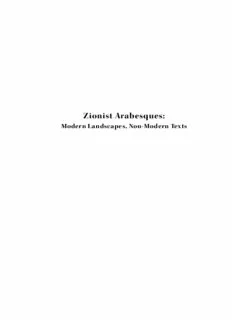
Zionist Arabesques: Modern Landscapes, Non-Modern Texts PDF
Preview Zionist Arabesques: Modern Landscapes, Non-Modern Texts
The Field, the Ethnography and the Anthropologist • 1 Zionist Arabesques: Modern Landscapes, Non-Modern Texts 2 • introduction ISRAEL: SOCIETY, CULTURE, AND HISTORY Series Editor: Yaacov Yadgar, Political Studies, Bar-Ilan University Editorial Board: Alan Dowty, Political Science and Middle EasternStudies, University of Notre Dame Tamar Katriel, Communication Ethnography, University of Haifa Avi Sagi, Hermeneutics, Cultural studies, and Philosophy, Bar-Ilan University Allan Silver, Sociology, Columbia University Anthony D. Smith, Nationalism and Ethnicity, London School of Economics Yael Zerubavel, Jewish Studies and History, Rutgers University The Field, the Ethnography and the Anthropologist • 3 Zionist Arabesques: Modern Landscapes, Non-Modern Texts Hadas Yaron Boston 2010 4 • introduction Library of Congress Cataloging-in-Publication Data Yaron, Hadas. Zionist arabesques : modern landscapes, non-modern texts / Hadas Yaron. p. cm. -- (Israel : society, culture and history) Includes bibliographical references and index. ISBN 978-1-934843-78-9 (hardback) 1. Jews--Colonization--Israel--Esdraelon, Plain of--History--20th century. 2. Jews-- Agriculture--Israel--Esdraelon, Plain of--History--20th century. 3. Agriculture--Palestine- -History--20th century. 4. Agriculture--Israel--Esdraelon, Plain of--History--20th century. 5. Agriculture, Cooperative--Palestine--History--20th century. 6. Kibbutzim--Israel-- Esdraelon, Plain of--History. 7. Collective settlements--Israel--History--20th century. 8. Labor Zionism--Palestine--History--20th century. 9. Esdraelon, Plain of (Israel)--History-- 20th century. I. Title. HD1516.I75Y37 2010 956.94'5--dc22 2010022360 Copyright © 2010 Academic Studies Press All rights reserved Cover and interior design by Adell Medovoy On the cover: Farid Abu Shakra. Ornament. 2005 Published by Academic Studies Press in 2010 28 Montfern Avenue Brighton, MA 02135, USA [email protected] www.academicstudiespress.com The Field, the Ethnography and the Anthropologist • 5 In memory of my mother, Sara 6 • introduction Notes on transliteration, translation and archives The transliteration of the Hebrew words in this book is based on the Library of Congress database. Certain names of people and places follow their spelling as specifi ed in academic and other offi cial publications or as they appear on the world-wide web. Words which could not be found in the Library of Congress database are written according to their sound. The translation of quotes either from the fi eld or archives follows as closely as possible not only the meaning but also the style of the quotation. The documents from the Public Records Offi ce which are quoted are cited according to the details of the documents (the document, reference number, date, correspondents) together with the number of the fi le. This style follows one of the options suggested by the Public Records Offi ce. The citation of the documents from the Public Records Offi ce, the Israel State Archive and the Middle-East Centre St. Anthony’s College Oxford, state the name of the document fi rst and the name of the archive and the number of the fi le last. Documents from other archives state the name of the archive fi rst followed by the details of the document. Certain documents from Israeli archives include Hebrew letters which in this manuscript are converted into numbers, or English letters. In certain cases I note that the number as it appears in the original fi le is in fact a Hebrew letter. Years which appear in Hebrew documents according to the Jewish calendar are converted here according to the Latin one, although where the month appears in its Hebrew form, I have written the name of the Hebrew month as it appears in the original document. The Field, the Ethnography and the Anthropologist • 7 Acknowledgements This ethnography is the result of a long journey, and I am grateful to all those who have assisted me throughout. I am indebted to Yael Navaro Yashin at Cambridge University who followed the project from its early beginnings, for her intellectual input and for her imaginative suggestions. I also thank Paola Filippucci for her support in the project and for her scholarly contribution. I wish to thank members at the department of Social Anthropology at Cambridge University and particularly Nikolai Scorin Chaikov as well as my colleagues for supporting the project and for their input and backing especially Ozlem Biner and Tanya Richardson. I am grateful to the Council for British research in the Levant and the Anglo Jewish Association for supporting the research. I am grateful to my friend Una Campbell who scrutinized this text, and ‘ironed’ it for me. I wish to express gratitude to the many people who made this research possible in the Jezreel valley, the people who opened their houses and their hearts to me and to whom I owe this ethnography. Lastly, I wish to thank my family. I wish to thank more than anyone my mother who taught me the love for novels and for history and who made this journey a unique intellectual and emotional experience for me, and to whom I dedicate this book. 8 • introduction The Field, the Ethnography and the Anthropologist • 9 Table of Contents Introduction: The Field, the Ethnography and the Anthropologist ...11 Chapter One: Conventional and Environmental Agriculture: The Modern, Anti Modern and Non Modern Landscapes ...27 Chapter Two: From Europe to the Middle East: Blossoming the Desert, Cultivating the Land of Israel ...83 Chapter Three: The State as a Plot: Who Owns the Land, Who Plans the Landscape ...149 Conclusions: Writing the Ethnographic Text: The Power of Words ...201 Notes ...207 Works Cited ...213 Index ...223 10 • introduction
Description: